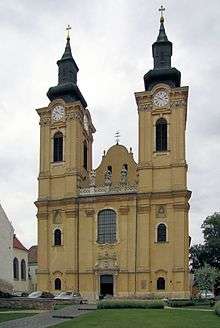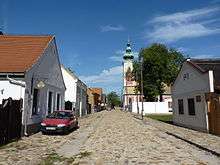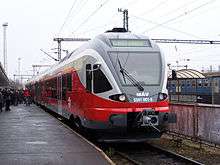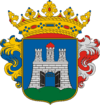Székesfehérvár
| Székesfehérvár | ||
|---|---|---|
| City | ||
.jpg)  .jpg)   | ||
| ||
| Nickname(s): Fehérvár, Hungarian Crowning City, City of Kings, City of Churches | ||
 Székesfehérvár Location of Székesfehérvár | ||
| Coordinates: 47°11′20″N 18°24′50″E / 47.18877°N 18.41384°E | ||
| Country | Hungary | |
| County | Fejér | |
| Area | ||
| • Total | 170.89 km2 (65.98 sq mi) | |
| Elevation | 118 m (387 ft) | |
| Population (2014) | ||
| • Total |
99,060 | |
| • Rank | 9th | |
| • Density | 579.67/km2 (1,501.3/sq mi) | |
| • Demonym | székesfehérvári, fehérvári | |
| Population by ethnicity | ||
| • Hungarians | 95.7% | |
| • Gypsies | 0.5% | |
| • Germans | 0.8% | |
| • Slovaks | 0.04% | |
| • Others | 2.96% | |
| Population by Religion | ||
| • Roman Catholics | 53.8% | |
| • Atheists | 19.7% | |
| • Calvinists | 12.1% | |
| • Lutherans | 1.9% | |
| • Greek Catholics | 0.5% | |
| • Others | 12% | |
| Time zone | CET (UTC+1) | |
| • Summer (DST) | CEST (UTC+2) | |
| Postal code | 8000 | |
| Area code(s) | 22 | |
| Website |
www | |
The city of Székesfehérvár (Hungarian pronunciation: [ˈseːkɛʃfɛheːrvaːr]; see also other alternative names), located in central Hungary, is one of the largest cities in the country. Székesfehérvár was the capital of Hungary in the Middle Ages. Now the city is regional capital of Central Transdanubia, the centre of Fejér county and Székesfehérvár District. It was one of the most important cities of Hungary. In the Székesfehérvár Basilica (one of the largest basilicas in medieval-Europe), where the Diets were held and the crown jewels kept, thirty-seven kings and thirty-nine queens consort were crowned and fifteen rulers buried. .
Names
The name Székesfehérvár means "white castle of the (royal) seat" and the city is known by translations of this in other languages (Latin: Alba Regia, German: Stuhlweißenburg, Slovak: Stoličný Belehrad, Serbian: Столни Београд, Stolni Beograd, Croatian: Stolni Biograd, Slovene: Stolni Belograd, Czech: Stoličný Bělehrad, Polish: Białogród Stołeczny or Białogród Królewski, Turkish: İstolni Belgrad). In Hungarian, the city is known colloquially as Fehérvár.
The word szék (meaning "seat" as "throne") is related to its important role in the 1st centuries of the Kingdom of Hungary: székhely means a (royal) residence, center. In accordance of the obligation from the Doctrine of the Holy Crown, the first kings of Hungary were crowned and buried here.[1]
History
Pre-Hungarian
The place has been inhabited since the 5th century BC. In Roman times the settlements were called Gorsium and Herculia. After the Migration Period Fejér County was the part of the Avar Khaganate,[3] while the Slavic and Great Moravian presence is disputed. (There is no source for the name of the place before the late 10th century.) In the Middle Ages its Latin name was Alba Regalis/Alba Regia. The town was an important traffic junction between Lake Balaton and Lake Velencei, several trade routes led from here to the Balkans and Italy, and to Buda and Vienna. (Today, the town is a junction of seven railroad lines.)
Early Hungarian

The Hungarian town was founded in 972 by High Prince Géza on four islands in the moors of the streams Gaja and Sárvíz. He also had a small stone castle built. Székesfehérvár was first mentioned in a document by the Bishopric of Veszprém, 1009, as Alba Civitas.
St. Stephen granted town rights to the settlement, surrounded the town with a plank wall, had a provosty and a school built and under his rule the construction of the Székesfehérvár Basilica began (it was built between 1003 and 1038). The settlement had about 3,500 inhabitants at this time and was the royal seat for hundreds of years. 43 kings were crowned in Székesfehérvár (the last one in 1526) and 15 kings were buried here (the last one in 1540).
In the 12th century, the town prospered, churches, monasteries, and houses were built. It was an important station on the pilgrim road to the Holy Land. Andrew II issued the Golden Bull here in 1222. The Bull included the rights of nobles and the duties of the king, and the Constitution of Hungary was based on it until 1848. It is often compared to England's Magna Charta.
During the Mongol Invasion of Hungary (1241–1242), the invaders could not get close to the castle: Kadan ruled Mongol warriors could not get through the surrounding marshes because of flooding caused by melting snow. In the 13th–15th centuries, the town prospered, and several palaces were built. In the 14th century, Székesfehérvár was surrounded by city walls.
After the death of King Matthias (1490), the Holy Roman army of 20,000 men of Maximilian invaded Hungary. They advanced in the heart of Hungary and managed to capture the city of Székesfehérvár, which he sacked, as well as the tomb of King Matthias, which was kept there. His Landsknechts were still unsatisfied with the plunder and refused to go for taking Buda. He returned to the Empire in late December and the Hungarian troops liberated Székesfehérvár in the next year.[4]
Ottoman period

The Ottomans occupied the city after a long siege in 1543 and only after a sally ended in most of the defenders including the commander, György Varkoch, being locked out by wealthy citizens fearing they might incur the wrath of the Ottomans by a lengthy siege. They discovered after surrendering, however, that the Ottomans were not without a sense for chivalry and those responsible for shutting the defenders out were put to death.
The city remained under Ottoman occupation for 145 years, until 1688, except for a short period in 1601 when it was re-occupied by an army led by Lawrence of Brindisi.[5] The Ottomans destroyed most of the city, they demolished the cathedral and the royal palace, and they pillaged the graves of kings in the cathedral. They named the city Belgrade ("white city", from Serbian Beograd) and built mosques. In the 16th–17th centuries it looked like a Muslim city. Most of the original population fled. It was a sanjak centre in Budin Province as "İstolni Belgrad" during Ottoman rule.
Habsburg Empire
The city began to prosper again only in the 18th century. It had a mixed population, Hungarians, Serbs, Germans, and Moravians.
By 1702, the cathedral of Nagyboldogasszony was blown up,[6] therefore destroying the largest cathedral in Hungary at that time, and the coronation temple. According to the Doctrine of the Holy Crown, all kings of Hungary are obliged to be crowned in this cathedral, and to take part in coronation ceremony on the surroundings of the cathedral. The coronations after this time were done in Pozsony/Bratislava.
In 1703, Székesfehérvár regained the status of a free royal town. In the middle of the century, several new buildings were erected (Franciscan church and monastery, Jesuit churches, public buildings, Baroque palaces). Maria Theresa made the city an episcopal seat in 1777.
By the early 19th century, the German population was assimilated. On 15 March 1848, the citizens joined the revolution. After the revolution and war for independence, Székesfehérvár lost its importance and became a mainly agricultural city. New prosperity arrived between the two world wars, when several new factories were opened.
After WWII


After World War II, the city was subject to the industrialization like many other cities and towns in the country. The most important factories were the Ikarus bus factory, the Videoton radio and TV factory, and the Könnyűfémmű (colloquially Köfém) aluminium processing plant, since acquired by Alcoa. By the 1970s, Székesfehérvár had swelled to more than 100,000 inhabitants (in 1945 it had only about 35,000.) Several housing estates were built, but the city centre was able to preserve its Baroque atmosphere. The most important Baroque buildings are the cathedral, the episcopal palace and the city hall.
In the past few decades, archaeologists excavated medieval ruins (that of the Romanesque basilica and the mausoleum of St. Stephen of Hungary) that can be visited now.
At the end of the Socialist regime, all important factories were on the verge of collapsing (some eventually folded) and thousands of people lost their jobs. However, the city profited from losing the old and inefficient companies as abundance of skilled labour coupled with excellent traffic connections and existing infrastructure attracted numerous foreign firms seeking to invest in Hungary and Székesfehérvár became one of the prime destinations for multinational companies setting up shop in Hungary (Ford and IBM are some of them), turning the city into a success story of Hungary's transition into a market economy. A few years later Denso, Alcoa, Philips, and Sanmina-SCI Corporation also settled down in the city.
Main sights
- Historical centre (Baroque, Classical) buildings
- St. Stephen Cathedral (burial place of several medieval kings incl. St. Stephen and Béla III)
- St. Anna Chapel (Gothic, built around 1470)
- "Ruin Garden": Ruins of medieval church founded by St. Stephen
- Episcopal Palace (Zopf style)
- City Hall
- Zichy Palace (Zopf style manor house, 1781)
- King Stephen Museum
- Doll Museum
- Museum of Fekete Sas Pharmacy
- City Museum
- City Gallery
- Csitáry source (mineral water source)
- Serbian Quarter (12 thatched peasant houses and a Byzantine-style church, won a Europa Nostra award in 1990)
- Golden Bull memorial (the Golden Bull was an important charta by King Andrew II, it was released here; the memorial is from 1972.)
- Bory Castle (20th century; a fantastic castle-like structure built by the sculptor Jenő Bory and his wife with their own hands)
- Globus crucifer (a stone image of the royal symbol of power of the same name)
- Statue of György Varkoch at the supposed site of his death at the gates (see above)
- Vörösmarty Theater, the oldest theater of the country
- Flower clock
Population
| Historical population | ||
|---|---|---|
| Year | Pop. | ±% |
| 1870 | 23,279 | — |
| 1880 | 26,559 | +14.1% |
| 1890 | 28,539 | +7.5% |
| 1900 | 33,196 | +16.3% |
| 1910 | 37,710 | +13.6% |
| 1920 | 40,352 | +7.0% |
| 1930 | 41,890 | +3.8% |
| 1941 | 49,103 | +17.2% |
| 1945 | 35,000 | −28.7% |
| 1949 | 42,260 | +20.7% |
| 1960 | 56,978 | +34.8% |
| 1970 | 79,064 | +38.8% |
| 1980 | 103,571 | +31.0% |
| 1990 | 108,958 | +5.2% |
| 2001 | 106,869 | −1.9% |
| 2011 | 100,570 | −5.9% |
| 2015 | 98,673 | −1.9% |
| 2021! | 95,000 | −3.7% |
| 2031! | 89,000 | −6.3% |
Ethnic groups (2001 census):
- Hungarians - 95.7%
- Germans - 0.8%
- Roma - 0.5%
- Others - 0.5%
- No answer - 2.4%
Religions (2001 census):
- Roman Catholic - 53.8%
- Calvinist - 12.1%
- Lutheran - 1.9%
- Greek Catholic - 0.5%
- Other (Christian) - 1%
- Other (non-Christian) - 0.2%
- Atheists - 19.7%
- No answer, unknown - 10.7%

Famous people
Born in Székesfehérvár
- Béla Balogh, film director
- Jenő Bory, sculptor, architect
- István Deák, historian
- Nándor Fa, who sailed around the Earth in a small boat
- George Fisher, settler, a leader of the Texas Revolution
- Ignác Goldziher, orientalist
- Katarina Ivanović, early 19th century Serbian Biedermeier painter
- Péter Kuczka writer
- Kornél Lánczos physicist
- Viktor Orbán Prime Minister of Hungary in 1998—2002 and 2010–present
- Katalin Bogyay journalist, diplomat
- Lajos Terkán astronomer
- Miklós Ybl architect
- George Lang restaurateur
- Dávid Disztl Professional Football player
- Raphael Rupert political prisoner during Stalinist regime
Fictional
- Albert Horn, character in Louis Malle's film Lacombe, Lucien.
Sports clubs
- Videoton FC (football)
- Székesfehérvári MÁV Előre SC (football)
- Szekeshfehervar Alba Volan HC (ice-hockey)
Twin towns - Sister cities
Székesfehérvár is twinned with:[7]
-
 Alba Iulia in Romania[7]
Alba Iulia in Romania[7] -
 Banská Štiavnica in Slovakia[7]
Banská Štiavnica in Slovakia[7] -
 Birmingham in United States[7][8][9][10]
Birmingham in United States[7][8][9][10] -
 Blagoevgrad in Bulgaria[7]
Blagoevgrad in Bulgaria[7] -
 Bratislava, Slovakia[11]
Bratislava, Slovakia[11] -
 Cento in Italy[7]
Cento in Italy[7] -
 Changchun in China[7]
Changchun in China[7] -
 Chorley in United Kingdom (since 1991)[7]
Chorley in United Kingdom (since 1991)[7] -
 Erdenet in Mongolia[7]
Erdenet in Mongolia[7] -
 Kemi in Finland[7]
Kemi in Finland[7] -
 Kocaeli in Turkey[7]
Kocaeli in Turkey[7] -
 Luhansk in Ukraine[7]
Luhansk in Ukraine[7] -
 Miercurea Ciuc in Romania
Miercurea Ciuc in Romania -
 Opole in Poland[7][12]
Opole in Poland[7][12] -
 Schwäbisch Gmünd in Germany[7]
Schwäbisch Gmünd in Germany[7] -
 Sariwon in North Korea
Sariwon in North Korea -
 Zadar in Croatia[7]
Zadar in Croatia[7]
See also
References
- Székesfehérvár, a királyi város (Székesfehérvár, the royal city)
- Notes
- ↑
 Chisholm, Hugh, ed. (1911). "Székesfehérvar". Encyclopædia Britannica 26 (11th ed.). Cambridge University Press.
Chisholm, Hugh, ed. (1911). "Székesfehérvar". Encyclopædia Britannica 26 (11th ed.). Cambridge University Press. - ↑ British Museum Collection
- ↑ See: Bóna István: Avar lovassír Iváncsáról [Grave of an Avar horseman at Iváncsa]. In: ArchÉrt 97. (1970). 243–264.
- ↑ József Bánlaky (1929). "Ulászló küzdelmei János Albert lengyel herceggel és Miksa római királlyal. Az 1492. évi budai országgyűlés főbb határozatai." [Struggle of Vladislas against prince John Albert and Holy Roman Emperor Maxinmilan. The assembly of Buda in 1492 and its sanctions.]. A magyar nemzet hadtörténelme [Military history of the Hungarian nation] (in Hungarian). Budapest, Hungary: Grill Károly Könyvkiadó vállalata. ISBN 963-86118-7-1. Retrieved 16 June 2011.
- ↑ Alban Butler, Paul Burns (2000). Butler's Lives of the Saints. p. 159. ISBN 0-86012-256-5.
- ↑ Ferenc Glatz: Magyar történeti kronológia
- 1 2 3 4 5 6 7 8 9 10 11 12 13 14 15 Bozsoki, Agnes. "Partnervárosok Névsora Partner és Testvérvárosok Névsora" [Partner and Twin Cities List]. City of Székesfehérvár (in Hungarian). Archived from the original on 2012-12-08. Retrieved 2013-08-05.
- ↑ "Székesfehérvár twin cities" (in Hungarian). Székesfehérvár.hu. Retrieved 18 July 2011.
- ↑ "Upcoming Birmingham Sister City Visitors" (pdf). Retrieved 18 July 2011.
- ↑ "Birmingham USA - Sister Cities". birminghamsistercities.com. April 23, 1982. Retrieved 2012-07-14.
- ↑ "Partner (Twin) towns of Bratislava". Bratislava-City.sk. Archived from the original on 2013-07-28. Retrieved 2013-08-05.
- ↑ "Miasta Partnerskie Opola". Urzad Miasta Opola (in Polish). Retrieved 2013-08-01.
External links
| Wikimedia Commons has media related to Székesfehérvár. |
| Wikivoyage has a travel guide for Székesfehérvár. |
- Székesfehérvár official site (English)
- Aerial photography: Székesfehérvár
- Picture Gallery of Székesfehérvár
- Székesfehérvár at funiq.hu (English)
| ||||||||||||||||||
| |||||||||||||||||||||
| ||||||||||||
Coordinates: 47°11′44″N 18°24′32″E / 47.19556°N 18.40889°E
|

